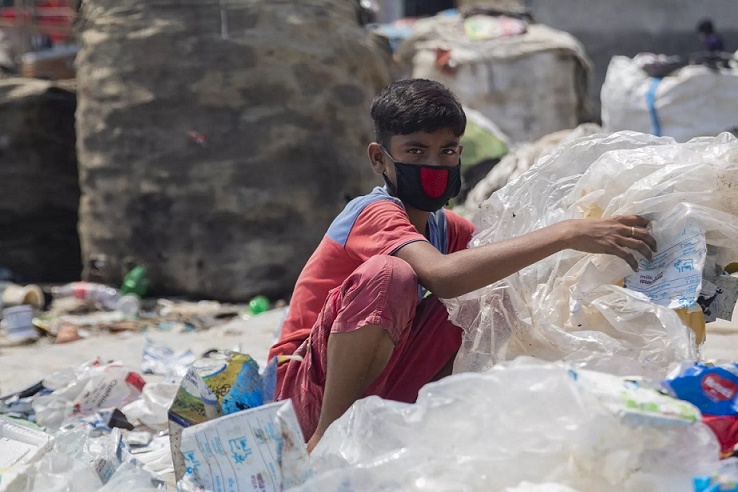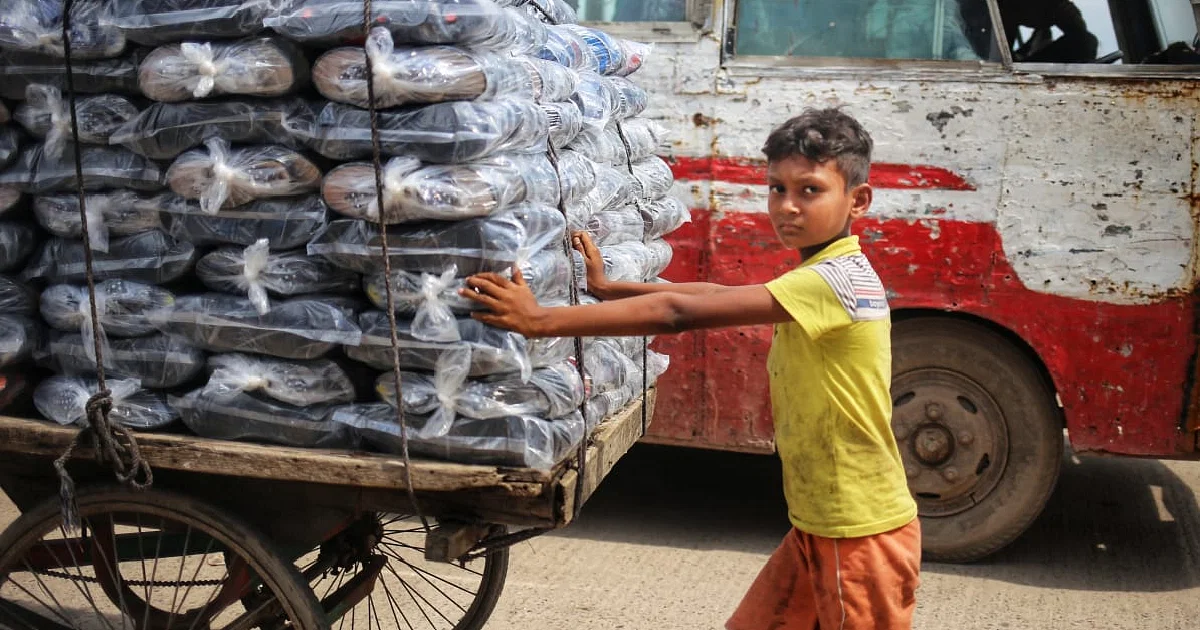Out of ten there is one working child worldwide. In poor and least developing countries (LDCs) one in five children are workers. There are 160 million working children across the globe. The working children’s calculating age is between 5 to 17. According to Bureau of Statistics (BBS) of 2022, collaborated with ILO, Bangladesh has 39.964 million children (5-17). Among the figure, working children are 3.537 million. Child labour is 1.776 million, on the top of that, hazardous child labour is 1.068 million.
However, the country’s first child labour consensus was held in 1995 then 2002-03, 2013 and 2022.
In 2013, the working children was 34 lakh 50 thousand 3 hundred 69 and in 2022 the amount won’t stop there and enhanced to figure like 35 lakh 36 thousand 9 hundred 27.
The total figure of child labour was 16 lakh 98 thousand 8 hundred 94 in 2013 and it stood 17 lakh 60 thousand 8 hundred 30 in 2022 survey of BBS. Though the country’s population is rising but the labour gap is scary as well.
Amidst all the negativity there is a statistical hope. According to BBS, the hazardous child labour (HCL) reduced by .50 percent between the gap of last BBS survey and that of 2013. In 2013, the HCL was 1,280,195 and in 2022 the amount stood at 1,068,212 children.
Bangladesh Labour Act (BLA)-2006, and National Children Policy-2011 collaborates and earmarked 14 years as the minimum age of work entry and permits adolescents only with the proper medication certificates under the rules.
Furthermore, BLA also identified and marked 43 types of work as worst form of work for children that includes manufacturing aluminium products, bidi, cigarettes manufacturing and others.
According to International Labour Organization (ILO)’s Worst Forms of Child Labour Convention 1999 (no. 182) and Recommendation no. 190, those works which have effects on physical, mental and psychological area and if any children works in a confined area that cause breathing problem and works in machinery sector and with machinery tools-equipment, work with high noise, high temperature, vibration that may lead health issues, transportation work that involves manual handling, under water works, work at dangerous height and sometimes faces sexual harassment is definitely hazardous and Worst Forms of Child labour.
Rajen, a 12-year-old-boy, works at Maa-Babar Doya Hotel at Capital’s Banasree area for almost 6 months. His home is in Lalmonirhaat. After asking why he is working in a hotel, he replied that he has none but doing this. His home was gone into Teesta river. After river erosion they settled elsewhere of the same district. It costs them much and broke their savings. His day labour father works hard but can’t bear all the expenses of their three siblings, family expenses and educational expenses especially. So his father sent him Dhaka with an acquainted guy (Rajon calls uncle) to earn a living on his own and help the family sometimes and his little sister and brother’s educational expenses in the future. He studied up to class five he said.
Bangladeshi previous Awami government passed The National Child Labour Elimination Policy (NCLEP) in 2010. And further The Shishu Ain or The Children Act-2013. NCLEP has had the objective of abolishing hazardous child labour (HCL) from the country within 2015 in line with the Millennium Development Goal (MCG) and by 2025 it was targeted to eliminate total child labour from country. But the reality was far from the policy and its target.
Azam, a gloomy faced sharp eyed 14-year-old boy, working in a motorbike shop in Capital’s 60 feet of Mirpur area, where he has to do the reforms of broken or semi damaged bike and cleaning, washing with bare hands and living with dust and dart almost 16 hours a day. When asking how far he has studied, he said that the has studied up to class 4 and said there is no pleasure and fun in study. He loves to gossip and play football. While asking do you enjoy the work? He said, I don’t want to work all the day with dust but I need money so I have to work. I have a sister, I will make her doctor one day.
The country is facing severe unemployment problem now. At one point the country has enormous amount of child labour with education and most of the portion without education. On the other hand, there is educated, graduated, post-graduated unemployed youth as well.
International Labour Organization (ILO) defines the child labour in many categories depending on age and working hour. If children aged between 5 to 11 work 1 hour at least in a week then he/she is a child labour. If children aged between 11 to 13 work 25 hours in a week and aged between 14 to 17 work 48 hours in a week will be considered as child labour.

To extend the topic further it is needed to describe some questions on defending the child labour in one’s mind. Let’s get into this.
Is Child Labour an Empowerment of Child?
We may get overwhelmed at a first glance that child labour could do a favour to them but deeply its not. They can earn some money but that’s not the empowerment. Because they eventually lack proper education and technical, theoretical knowledge of the upper layer of the work and world. If they work only for money they will metamorphosis into a physical labour and when will they lose their physical strength they will be thrown into darkness where no one give them a hand to touch the sky again. On the top of that, empowerment means autonomy and self-determination and freedom of choice. If they haven’t had study and don’t involve into ideas and value generating field their autonomy won’t last and will lead them into a forgotten chapter of our collective capitalistic memory.
And a child doesn’t choose to work at her age. It is her father and guardian who choose for her what to do and not to. So, while you can’t make decision of your own then how does it become self-empowerment?
Is Child Labour Helps to Acquire Dexterity?
We know a proverb that says practice makes a man perfect. So why is it false for a child labour? Child labour may help for a bit but in the long run it will cause the harm of physical and mental health and consecutively the working capacity in the future. Working under 18 will not aid to get prosperity because they will be vexed with working life and much of their work not be noticed because they don’t do the critical and brainstorming job but merely physical labour. In the end, physical job doesn’t matter in the world of idea and creation. So there will be no chance to be adroit in higher kind of brainstorming works.
Can Work and Education Be reconciled?
Many a man think that work and study can be negotiated. Children can work and study at the same time. If they do then they would have a trouble. It will hamper both the mental capacity of working further and may lead the physical imbalance, derogate the nutrition and worsen the competitive education process. If work and study run together then the time will be divided into both ways.
What made trouble?
However, the reason in behind of rising child labour gradually in poor countries and developing countries are the socio-economic in its root. Economy is the sole reason in behind of everything. The poor lack adequate money and infrastructure to lead to the progress and it is true in context of the lower middle and for working class population. In capitalism, low-priced labour is crucial for the benefit of surplus money as Karl Marx put it grossly named as profit. In industry base economy there is a huge need of low wage workers and most of the low wage workers are uneducated coherently. They have the dire need of living and they lack of proper professional knowledge as they don’t have education and miss the creative and higher role in workplace. So what they merely have is physical labour, they offer their physical strength and earn some to live. That is the sole and vital point of capital growth of the industry base capitalism. They buy labour from poor with a handful of money and on the contrary big guns lift their account much higher. The vicious cycle is that the poor remains the poor and the wealthy get wealthier.
However, Bangladesh has seen a student led mass uprising against the Awami League government and its repressive authoritarian fascist rule and they were ousted on August 5 this year. Then an interim government has formed to rule the country and to reform almost everything like constitution, election commission, and so on. But till now there is no discussion ongoing about child labour and its whereabouts. No new policy has been taken on it. Although there is a policy to eliminate the child labour and compulsory primary education and restriction on child labour at least up to age 14. Nonetheless, we are human at the end of day and we dream about a flawless life for our own and for other in our altruistic perspectives.
It will be a better way out to eliminate the child labour if our policy makers and government take a wider and bolder step like offering a sustainable amenity packages for working children, enlist vulnerable children and ensure an allowance for further education and health and nutrition and it would be an effective idea to make an announce to all of the business hub and shop, centre and traders that if they hire a child under 17 they must enlist their name in relevant office of govt and let the govt know officially. And company or traders will ensure that the child won’t be abused in any forms and they will ensure his children rights and basic education too. As it is said in section 41 (C) in Labour Law 2006 of Bangladesh that no children can engage in works in night shifts, specifically from 7 pm to 7 am. It also should be practiced and obeyed by hirer and govt should supervise strictly to make them (child labour) room for relaxation and their flourishment.
Last but not least, we should think critically from the narrative of cause and effect and act fast to eradicate discriminatory system to uplift our nation and our very own people. We can now hope that there will be a day when we will be able to eliminate the child labour and make sure a world where no odds will be carried out.
ZH






